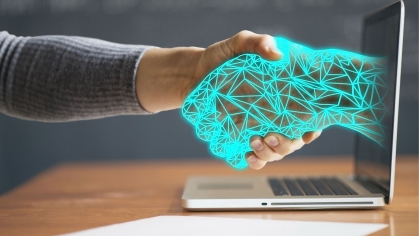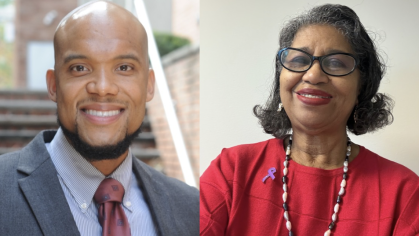How to Commemorate National Suicide Prevention Week: A Personal and Professional Discussion with Bridget Nash
Bridget Nash, Rutgers School of Social Work lecturer since 2014, graduate of the Rutgers DSW and MSW programs, and a social worker who has been in clinical private practice for over 15 years, discusses how social workers can commemorate Suicide Prevention Week, which takes place Sunday, September 8th through Saturday, September 14th. She shares her own experience as both a teacher, clinician, and sister of someone who lost her battle with mental illness.
Suicide prevention, as we know it today, has been evolving for decades. In 1968, Edwin S. Shneidman established the American Association of Suicidology (AAS) after co-directing the Los Angeles Suicide Prevention Center (LASPC) and was next appointed co-director of The Center for Suicide Prevention at the National Institute of Mental Health (NIMH) in Bethesda, MD. There he had the opportunity to closely observe the paucity of available information regarding suicide. Consequently, under the sponsorship of the NIMH, he organized a meeting of several world-renowned scholars in Chicago, determined the need for, and fathered a national organization devoted to education, research, and practice in “suicidology,” and advancing suicide prevention. Interestingly, during his years of leadership directing a suicide prevention center, Shneidman recognized the need for a rapid expansion of the crisis center and hotline movement across the United States (Lsherman, 2023). Since 1975, the American Association of Suicidology sponsors National Suicide Prevention Week (NSPW) activities. NSPW awareness events are held throughout the week corresponding to World Suicide Prevention Day, from Sunday, September 8th through Saturday, September 14th. The NSPW also offers trainings for clinicians called Recognizing and Responding to Suicide Risk: Essential Skills for Clinicians where social workers can learn the 24 core competencies for clinical risk assessment and treatment for people at risk for suicide (Lsherman, 2024). With increasing awareness of the importance of combining crisis intervention with the hotline technology, the Substance Abuse and Mental Health Service Administration (SAMHSA) launched the 988 Suicide & Crisis Lifeline in 2005. This life-saving service provides free and confidential support to individuals experiencing suicidal thoughts or emotional distress, 24 hours a day, seven days a week, across the United States. The Lifeline works in partnership with local crisis centers to provide community resources using national best practice standards.
Tell us a bit about your journey to social work.
When I was 17 years old, I was drinking alcohol heavily and skipping school, so my parents sent me to an adolescent rehabilitation center for alcohol use disorder. When I was in the car ready to drive to a treatment center in Pennsylvania, my sister, Sheila, who was also suffering from the effects of addiction, asked our parents if she could go to treatment with me. My parents emphatically said “yes” as my father was in Alcoholics Anonymous, and my mother was in Al-Anon for over 20 years. Unfortunately, when we arrived at the rehab, the admissions counselor placed Sheila in a separate unit for adults, even though she had only recently turned 18. Against medical advice, Sheila left that treatment center after only one week. With young people suffering from addiction, it is critical for them to be in an environment where they can identify with others in order to capitalize on their motivation, however fragile, for change. I believe the decision to place Sheila in an adult unit was the beginning of a series of events that led to her death.
What is the significance of Suicide Prevention Week for you?
Sheila’s death at 47 years old was not officially deemed a suicide. However, the circumstances surrounding her death, that she died alone on her bathroom floor after suffering from her last episode of addiction and serious mental illness, still leaves me to wonder whether she took her own life. Mental illness can be as excruciatingly painful as any physical pain one can imagine, and I know my sister suffered for decades with unimaginable mental distress. I, on the other hand, left the rehabilitation center at seventeen and have been sober ever since. Not only have I had the blessing of sobriety over the past 40 years, but I have also benefited from receiving the best evidence-based therapy available. Truth be told, I suffer from a level of survivor’s guilt, and that is one of the reasons I went into the field of clinical social work. My passion is to help as many people know about, and receive, lifesaving evidence-based therapies so they can experience a life worth living.
How can the social work community recognize and commemorate Suicide Prevention Week?
Social workers are on the front lines of suicide prevention as they not only assess client’s suicidal ideations, but also provide life-saving treatment for individuals who are experiencing mental distress and suicidal thoughts. As a clinical social worker, I understand first-hand how much social workers do on the micro, macro, and mezzo levels, so I am reluctant to ask them to do one more thing. However, it is imperative that social work students and social workers in the field master and employ suicide assessment tools designed to identify and prevent future suicides. One of the tools I teach my Clinical Assessment and Diagnosis students to use is Suicide Assessment Five-Step Evaluation and Triage, more commonly referred to as SAFE-T. This tool was created by Dr. Douglas G. Jacobs to assess suicide risk factors, identify protective factors, conduct a suicide inquiry, determine the level of risk, choose the appropriate intervention, and develop an intervention plan and follow up treatment. I believe the best way social workers can recognize and commemorate the importance of Suicide Prevention Week is to take a moment and refresh their suicide prevention skills. There are so many training resources on the internet, and Dr. Jacobs and his colleague Dr. Carsen Sulzer of McLean Hospital offer the SAFE-T Suicide Assessment Protocol, a free professional course for mental health clinicians to learn how to use the SAFE-T protocol. In this course, Drs. Jacobs and Sulzer highlight the risk factors for suicidality such as a past history of a psychiatric disorder, substance use disorder, suicidal ideation, as well as suicide-specific symptoms such as shame, rage, humiliation, and psychological pain. From my personal perspective, my sister suffered from every one of these risk factors. From my clinical social work experience, other risk factors include a family history of suicide, starting or stopping a psychotropic medication, current or prior history of trauma, discrimination, bullying, loss of relationships, and many others (CDC, n.d.-a; Gibbons, et al., 2007).
What can the social work profession or social workers do to continue to support the importance of Suicide Prevention Week beyond this month?
It is important for social workers to be aware of current statistics on suicide, as they inform assessment and practice interventions. According to Centers for Disease Control, over 49,000 people died by suicide in 2022. That is one death every eleven minutes. Approximately 13.2 million people have serious suicidal thoughts, 3.8 million individuals have made a plan for suicide, and 1.6 million people have attempted suicide (CDC, n.d.). It is also important to be aware that some racial/ethnic groups have disproportionally high rates of suicide, with American Indian and Alaska Native the highest at 28.1 suicides per 100,000 in 2021. Historically, non-Hispanic white individuals have had steadily increasing suicide rates, but recent data shows a decline in suicide rates for non-Hispanic whites, and a rise in suicide rates for non-Hispanic Black or African American persons (CDC, 2022, October 21). Coimbra and colleagues (2022) in their meta-analysis, found that racial discrimination and the unfair treatment of individuals based on race or ethnicity had a small statistically significant effect on suicide attempts. There is evidence that racial discrimination is on the rise, due to political shifts and the pervasiveness of, and exposure to, social media leading to psychological distress for many people (Coimbra, et al., 2022). Because of this, we may expect an increase in suicide among individuals experiencing discrimination.
According to Johns and colleagues (2020), LGBTQ+ young people are more than four times as likely to attempt suicide than their peers. The Trevor Project, a leading suicide prevention and crisis intervention organization dedicated to support LGBTQ+ young people, states that that LGBTQ+ young people are not inherently prone to suicide due to their sexual orientation, but rather develop a higher risk because of how they are mistreated by society. There are some protective factors for LGBTQ+ young people such as having at least one accepting adult in their life, social support from family, living in an accepting community, and an affirming environment including school and home (Facts about Suicide, 2024a).
Another group vulnerable to suicide is veterans. Suicide was the thirteenth leading cause of death among veterans overall, and the second leading cause of death among veterans under age 45. Veterans have an age-adjusted suicide rate that is 57.3% greater than the non-veteran U.S. adult population. Veterans account for about 13.9% of suicides among adults in the United States. The Veterans Administration (VA) conducts a large-scale analysis of veterans suicide rates each year along with a brief summary of their suicide prevention initiatives in Appendix A. The VA is working to expand communication campaigns for targeted diverse populations through three of the following campaigns: Don’t wait, Reach out; Keep It Secure and the Veterans Crisis Line (dial 988 then press 1) where there is continuous, confidential, crisis support for veterans and their loved ones.
Why is it important for social workers at all levels of practice to know about the statistics related to suicide and the factors that contribute to suicide?
Policy social workers can focus on social and political factors that contribute to these increasing trends in order to understand the levers that need to be pushed on a macro level to lower suicide rates for all individuals. Social workers that work on the mezzo level can work with groups to provide resources for people in their communities. Micro social workers can help individuals and families recognize signs of suicidal behavior so that everyone in a client’s life is working in unison to provide safety, stabilization, and treatment.
Suicidal Behavior Disorder, a proposed separate diagnosis in the Diagnostic and Statistical Manual, Fifth Edition, is a behavioral or psychological syndrome or pattern that can include cognitive, emotional, temperament and personality domains along with biological markers associated with risk including the central nervous system (APA, 2013). Dr. Ursula Whiteside is a licensed clinical psychologist and a member of the clinical faculty at the University of Washington. I had a chance to interview Dr. Whiteside for my podcast, Therapy Show, on suicidal behavior disorder (click here). Dr. Whiteside trained under Dr. Marsha Linehan, the creator of Dialectical Behavioral Therapy, and later served as a DBT-adherent research therapist on a clinical trial led by Dr. Linehan that was funded by the National Institute of Mental Health. Dr. Whiteside is the CEO of NowMattersNow.org, which was conceived from her research study involving over 18,000 high-risk suicidal patients in four major health systems. This study includes a guided version of NowMattersNow.org which is a program she developed that includes skills for managing suicidal thoughts and is based on DBT and paired with lived experience stories. Dr. Whiteside is national faculty for the Zero Suicide Initiative, a practical approach to suicide prevention in healthcare and behavioral healthcare systems. Dr. Whiteside serves on the faculty of the National Action Alliance Zero Suicide Academy. She is also a founding board member of United Suicide Survivors International and a member of the Standards Trainings and Practices Committee for the National Suicide Prevention Lifeline. As a person with lived experience, she strives to decrease the gap between “us and them” and to ensure that the voices of those who have been there are included in all relevant conversations. “Nothing about us without us.”
I believe it is important to support social workers by giving them powerful resources they can access easily online so that they can ultimately help prevent as many suicides as possible by assisting individuals to heal the underlying cause of their mental distress. Dr. Whitehouse refers to a “stop, drop, and roll” metaphor in my podcast interview as she believes that the skills necessary to prevent suicide need to be taught as early as possible and be as reflexive as knowing what to do when your house is on fire – stop, drop and roll. If we can do that as a society, teach suicide prevention early, then we can go a long way toward assisting social workers in their important mission of reducing suicide rates.
References
Diagnostic and statistical manual of mental disorders: DSM-5. (2017). CBS Publishers & Distributors, Pvt. Ltd.
Coimbra, B. M., Hoeboer, C. M., Yik, J., Mello, A. F., Mello, M. F., & Olff, M. (2022). Meta-analysis of the effect of racial discrimination on suicidality. SSM - Population Health, 20, 101283. https://doi.org/10.1016/j.ssmph.2022.101283
Centers for Disease Control and Prevention. (n.d.-a). Health disparities in suicide. Centers for Disease Control and Prevention. https://www.cdc.gov/suicide/disparities/index.html#cdcreference_7
Centers for Disease Control and Prevention. (2022a, October 21). Products - data briefs - number 450 - November 2022. Centers for Disease Control and Prevention. https://www.cdc.gov/nchs/products/databriefs/db450.htm#ref1
Centers for Disease Control and Prevention. (n.d.-a). Risk and protective factors for suicide. Centers for Disease Control and Prevention. https://www.cdc.gov/suicide/risk-factors/index.html
Centers for Disease Control and Prevention. (n.d.). Suicide data and statistics. Centers for Disease Control and Prevention. https://www.cdc.gov/suicide/facts/data.html
Facts about suicide among LGBTQ+ young people. The Trevor Project. (2024a, July 2). https://www.thetrevorproject.org/resources/article/facts-about-lgbtq-youth-suicide/
Gibbons, R. D., Brown, C. H., Hur, K., Marcus, S. M., Bhaumik, D. K., Erkens, J. A., Herings, R. M. C., & Mann, J. J. (2007). Early evidence on the effects of regulators’ suicidality warnings on SSRI prescriptions and suicide in children and adolescents. American Journal of Psychiatry, 164(9), 1356–1363. https://doi.org/10.1176/appi.ajp.2007.07030454
Johns, M. M., Lowry, R., Haderxhanaj, L. T., et al. (2020). Trends in violence victimization and suicide risk by sexual identity among high school students — Youth Risk Behavior Survey, United States, 2015–2019. Morbidity and Mortality Weekly Report, 69, (Suppl-1):19–27.
Lsherman. (2023, October 3). History. American Association of Suicidology. https://suicidology.org/history/
Lsherman. (2024, July 2). Recognizing & responding to suicide risk: Essential skills for clinicians©. American Association of Suicidology. https://suicidology.org/training-certifications/rrsr-clinicians/
McLean videos | the safe-T suicide assessment protocol: Integration into the EMR and assignment of suicide risk. (n.d.). https://www.mcleanhospital.org/video/safe-t-suicide-assessment-protocol-integration-emr-and-assignment-suicide-risk
2023 National Veteran Suicide Prevention Annual Report. (n.d.-a). https://www.mentalhealth.va.gov/docs/data-sheets/2023/2023-National-Veteran-Suicide-Prevention-Annual-Report-FINAL-508.pdf
Safe-T pocket card: Suicide assessment Five-step evaluation and triage for clinicians. SAMHSA Publications and Digital Products. (n.d.). https://store.samhsa.gov/product/SAFE-T-Pocket-Card-Suicide-Assessment-Five-Step-Evaluation-and-Triage-for-Clinicians/sma09-4432
Va.gov: Veterans Affairs. Veteran Suicide Data and Reporting. (2018, September 14). https://www.mentalhealth.va.gov/suicide_prevention/data.asp
Veterans Crisis Line. (n.d.). https://www.veteranscrisisline.net/
988 Suicide & Crisis Lifeline. (n.d.). https://988lifeline.org/about/
This story was created in partnership with Rutgers School of Social Work's Inclusion, Intersectionality, Diversity, Equity, and Advancement (IIDEA) Committee.



